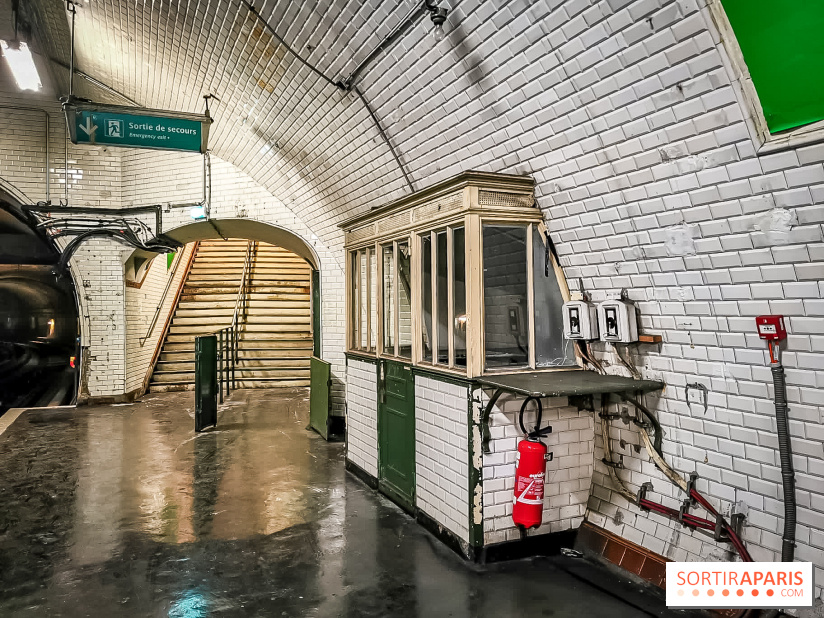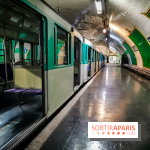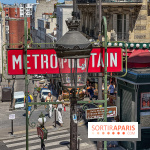Their names are Croix-Rouge, Saint-Martin or Arsenal. What do they have in common? They're ghost stations. In fact, Paris is home to a dozen abandoned underground stations that are never used by commuters. The best-known of these? The Porte des Lilas station, often used for film shoots or advertising.
But there are several other, lesser-known ghost stations scattered around the capital. Operated and then closed due to a lack of ridership, or built but never opened to passengers, or relocated... an overview of the ten or so ghost stations in Paris.
Among the ghost stations are those closed in September 1939, at the start of the Second World War. "On the day of mobilization, due to a lack of personnel, 173 of the 332 stations in existence at the time were taken out of service. The network shrank from 159 to 93 kilometers," explained Philippe Ventejol, head of network development at RATP, in Le Point in 2012. Due to a lack of passengers, or the modification of the RATP network years later, several of these stations never reopened to passengers.
This is particularly true of the Croix-Rouge station (line 10). Located between the Mabillon and Sèvres-Babylone stations, it was the first terminus of line 10 in 1923. Despite its closure, the Croix-Rouge station has continued to live on as a backdrop for advertising and film shoots, including a video for Étienne Daho. In 2019, the Croix-Rouge station is back in the news with a conversion project. Following a call for projects launched by the City of Paris, the station could have been transformed into a restaurant. Unfortunately, due to a number of technical problems, the Terminus restaurant never saw the light of day.
Also closed shortly before the Second World War, Champ de Mars station (line 8) was deemed too close to La Motte-Picquet - Grenelle station, already served by three lines (6, 8 and 10). The Champ de Mars station, opened in 1913, was considered to be infrequently used and therefore unprofitable, and closed for good in September 1939.
Saint-Martin station (lines 8 and 9) was also one of the stations operated before the Second World War, but eventually closed. Located on lines 8 and 9 between Strasbourg Saint-Denis and République stations, this former station welcomed passengers between 1932 and 1939. Also deemed too close to the neighboring Strasbourg - Saint-Denis station, Saint-Martin finally closed its doors. But thanks to its 440 m² underground passageway, the station was also used for advertising purposes. In 2010, during the traditional Nuit Blanche, the station even reopened its doors to present a creation by the École nationale supérieure des arts décoratifs (ENSAD).
Arsenal station (line 5), opened in 1906, was also forced to close its platforms to passengers at the start of the Second World War. Located between Bastille and quai de la Rapée stations, above the tunnels of lines A and D, Arsenal station is featured in the 1965 film"La Grosse Caisse", starring Bourvil.
Another metro station that was opened, but eventually closed, was Martin Nadaud. Located in the 20th arrondissement of Paris, this station was in fact the former terminus of line 3, between 1905 and 1921. In 1969, when Gambetta station was remodeled, Martin Nadaud station was absorbed into it, permanently ceasing to welcome passengers. In 1971, it even became a corridor of Gambetta station.
Two open stations have dead platforms, meaning they are inaccessible to the public: Invalides station (line 8) does exist today. However, part of the platform towards Balard is not accessible to the public.
Another ghost station on a dead platform? Porte des Lilas station. Opened on November 27, 1921 as the terminus of line 3 from Porte de Champerret, Porte des Lilas station (lines 3 bis and 11) eventually operated until 1939 with a Pré-Saint-Gervais - Porte des Lilas shuttle. Today, Porte des Lilas is certainly the best-known of the ghost stations. For several years now, the station's dead platform has been the location of numerous film shoots ("Ronin","Le Fabuleux Destin d'Amélie Poulain","Les Femmes de l'ombre"...).
The Cinema Station: when RATP and the 7th art meet at the Porte des Lilas
This ghostly station located at Porte des Lilas, in Paris, could have a place at the Cannes Film Festival: countless films, commercials and video clips have been shot there, just a stone's throw from the metro passengers. Discover the Cinema Station, the most mysterious and magical place of the RATP. [Read more]
Ever heard of Haxo station? Well, this one never opened! Located under the boulevard Sérurier in Paris's 19th arrondissement, on the connecting track between lines 3 bis, at the Porte des Lilas station, and 7 bis, at the Place des Fêtes station, the Haxo station never saw the light of day. Although its external accesses were never built, Haxo station is very real. It was possible to visit it during the Heritage Days, via the ADEMAS association.
Like the Haxo station, the Porte Molitor station (lines 9 and 10) has never seen a single passenger. Built in 1923, this ghost station - located in the 16th arrondissement of Paris - was intended to serve the Parc des Princes stadium on match nights. Today, it is used as a siding for trains on lines 9 and 10.
Who hasn't got on or off at Gare du Nord station (lines 4 and 5)? One of the capital's busiest stations has actually been moved. Its ghost station is the former loop terminus of the old line 5.
Some may not know it, but Porte Maillot station was the first terminus of line 1, opened in 1900. At the time, it was built in a loop at the same level as the Petite Ceinture line. The consequence? No extension was possible. So a new, deeper station was built in 1936 to extend the line to Pont de Neuilly. The Porte Maillot station was moved, but the platforms were retained.
Today, these ghost stations do not appear on RATP plans and are inaccessible. And yet, they fascinate a great many Parisians, curious to visit these hidden, disused places.
The most astonishing metro stations in Paris: the highest, the deepest...
Paris metro stations hide some amazing features that you'd never suspect when you take the train. Find out which metro station is the highest, the deepest or the least crowded! [Read more]
Metro line 15: Abbesses to no longer be the deepest metro station
For always, the Abbesses metro station was known for being the deepest one in the Ile-de-France network. But it will be soon dethroned by an upcoming station on metro line 15, in Val-de-Marne. [Read more]







 The Cinema Station: when RATP and the 7th art meet at the Porte des Lilas
The Cinema Station: when RATP and the 7th art meet at the Porte des Lilas


 The most astonishing metro stations in Paris: the highest, the deepest...
The most astonishing metro stations in Paris: the highest, the deepest...


 Metro line 15: Abbesses to no longer be the deepest metro station
Metro line 15: Abbesses to no longer be the deepest metro station














